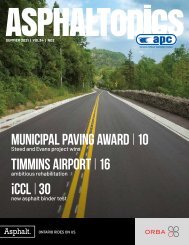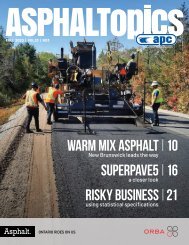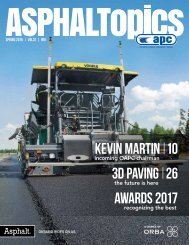ASPHALTopics | Summer 2014 | VOL 27 | NO3
You also want an ePaper? Increase the reach of your titles
YUMPU automatically turns print PDFs into web optimized ePapers that Google loves.
One of OHMPA’s most significant contributions to<br />
the industry is its Environmental Practices Guide (EPG)<br />
which has the endorsement of the Ontario Ministry of the<br />
Environment and Climate Change (MOECC) and has been<br />
adopted by various industry organizations in the U.S. EPG<br />
is designed to assist plant operators in the operation and<br />
maintenance of their facilities by providing best practices<br />
in environmental management.<br />
The comprehensive EPG covers environmental<br />
regulations governing HMA production and HMA<br />
production emissions that are generated on-site.<br />
Environmental best practices are provided for all<br />
aspects of HMA plant operations. The EPG covers air<br />
and noise emissions management, waste management,<br />
and water management, and recommends that each<br />
plant have a site specific Dust Management Plan and<br />
Spills Contingency Plan. Sample checklists are provided<br />
to assist plants in incorporating best practices. A complaint<br />
response form ensures that operators gather all of the<br />
necessary information in the event of a complaint so<br />
that a comprehensive response can be provided.<br />
OHMPA’s EPG is so influential it is referenced in<br />
applications for Environmental Compliance Approval<br />
(ECA) (air & noise) by the MOECC and is a mandatory<br />
component of qualifying for a Trillium Award. The EPG<br />
helps operators to not only improve their environmental<br />
stewardship, but also to become more efficient and<br />
competitive for an improved bottom line.<br />
“The Environmental Practices Guide is a very progressive<br />
tool,” says Bridget Mills, a Partner with BCX Environmental<br />
Consulting in Newmarket. “It’s so successful that, as part<br />
of the ECAs (air & noise), facilities must follow the air and<br />
noise components of the EPG. Through this the Ministry<br />
acknowledges that the hot mix industry has developed<br />
very good environmental best practices to minimize air<br />
emissions.”<br />
This parking lot is porous on the right and<br />
impervious on the left. The difference in how<br />
water is handled is immediately obvious.<br />
40 OHMPA | ASPHALTOPICS


















